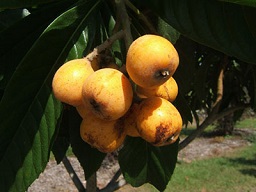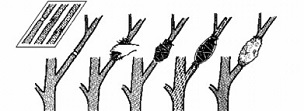Article from Okeechobee News
by Dan Culbert - Okeechobee County Extension Horticulture Agent, Retired
Loquat Has Many Uses

Fig. 1
Multi-tasking
applies to more than busy people. Plants can do double duty as
well. Loquat trees are a good example. They are a small attractive
shade tree with fragrant flowers and spring fruit, the subject of this
week’s column.
According to Retired Osceola County Extension
Agent Eleanor Foerste, the loquat may be considered for Florida Yards
that are cramped for space but seeking fast shade. Loquats are
ideal for small yards as they only grow to 25 feet tall. They have
large dark green leaves and naturally form a spreading umbrella shape
suitable for creating shady areas for benches or swings.
Despite
their name, Loquats are not related to the citrus relative,
kumquat. Instead, they are distant cousins to apples and
pears. Another name for this tree and its fruit is Japanese Plum,
which gives a hint of where this plant originated.
Loquat trees
bloom in the early winter. This year I’ve seen bumper crops
of Loquat fruit in our area. If the blooms are damaged by temperatures
below 28°F they may lose the winter fruit crop, but the trees will
survive.
Large clusters of small fuzzy yellow fruit are
found on loquats from February through March. Their oval shaped
fruit is sweet and juicy, and they usually have only a single pit.
Fruit can be eaten fresh or made into preserves. Pinch off the
blossom end, squeeze the seed out and pop the fruit in your mouth for a
tasty treat.
While these broadleaf trees are considered
evergreen, they also lose leaves all year long. If placed away
from turf areas, leaf pickup tasks can be reduced by leaving a mulched
bed area under the tree. The large brown leaves are not as obvious
in a brown mulched bed as they are on a green lawn. Mulch
decomposes and enriches our sandy soil as it holds moisture and
nutrients. Keeping them away from sidewalks and drives also avoids
the problems of cleaning up unharvested fruit as well.
Loquats
are best suited to full sun areas and well drained soil. Avoid
planting them in soggy areas. They will do well in either sweet
(alkaline) or sour (acid) soils.
If loquats are grown from
seeds, the fruit will be slow to appear and their quality will be
unpredictable. If possible, look for named varieties such as
‘Gold Nugget’ or ‘Champagne.’ Other favorites
at nurseries carrying dooryard fruit are ‘Oliver’,
‘Wolf’ and ‘Tanaka.’
If a friend has a
tree with tasty fruit, air layering can be used to produce a clone of
your friend’s desirable tree. Air layering is a fun way to grow
roots on the tree’s stem while it is still attached to the
tree. The mother plant provides water while the shoot is
developing roots so survival is often higher than with rooting cuttings
from the tree.

Fig. 2
Air layering. Progressive steps to making an air layer (from left)
Here’s
how to air layer a Loquat. Remove a few leaves between 8" and 12"
from the shoot tip, leaving a 4" to 6" stem section
exposed. Scrape the bark from a one inch section of the stem all
the way around. Applying a small amount of rooting powder on the
cut area with a small paint brush or cotton swab speeds up the
rooting. Pre-soak with water two hands full of sphagnum moss
then gently squeeze to remove dripping water.
Hold the
sheet of plastic wrap in your hand and place the clump of wet sphagnum
moss on top. Press a crease in it and fold it around the cut part
of the stem. Hold the plastic tightly and secure the bottom edge
to the stem with a wire twist tie. Carefully fold the edges of the
plastic together to form a good seal in the moist moss. (This wrapping
process is easier if an extra set of hands is available.)
The
plastic holds the moss against the cut stem and provides a moist place
for roots to grow while it is still attached to the original mother
plant. Many experienced propagators also cover the plastic with foil to
prevent sunlight from damaging tender new roots. Birds are also
sometimes known to peck at the worm like roots.
Watch
for the roots grow inside the plastic. After a month or so, when
the roots fill the moss, cut the shoot BELOW the rooted area so the new
cutting has roots. Don’t cut above the roots or the new
plant will lack roots. This rooted cutting can be grown out in a
pot for a period of time before it is planted in the yard.
Loquats
are easy care plants which require little pruning. Fertilize once
or twice a year with any garden or fruit fertilizer. Water
may be needed during dry winter and spring weather when fruit is
forming, but avoid over watering.
Keep an eye out for fruit
flies that can attack loquat fruit. Fire blight disease is a
problem some years. This bacterial disease attacks young shoots
and causes them to turn brown and dead leaves hang on the
stems. To stop this disease, trim out damaged stems well into
green tissue. To avoid spreading the disease, dip pruning
clippers in a dilute bleach solution (one part bleach to 9 parts water)
between cuts.
Home gardeners can have it made in the shade by
selecting Loquat as an edible shade tree. Here are a few other sources
of information on Loquats:
• UF/IFAS Extension Service: Loquat Growing in the Florida Home Landscape. http://edis.ifas.ufl.edu/MG050
• UF/IFAS Gardening Solutions: Loquat. http://gardeningsolutions.ifas.ufl.edu/plants/trees-and-shrubs/trees/loquat.html
• Julia F. Morton, Fruits of Warm Climates –
Loquat https://www.crfg.org/pubs/ff/loquat.html
• Ty Ty Nursery – Loquats https://www.tytyga.com/Loquat-Trees-s/1856.htm
|
|
Bibliography
Culbert, Daniel F. "Loquat Has Many Uses." Feature Article for Okeechobee News, March 12, 2006, 2018, UF/IFAS, Okeechobee County Extension Service, AskIFAS, okeechobee.ifas.ufl.edu.
Photographs
Fig. 1 "Loquat." UF/IFAS Gardening Solutions, gardeningsolutions.ifas.ufl.edu/plants/trees-and-shrubs/trees/loquat.html. Accessed 24 May 2018.
Fig. 2 "Air layering. Progressive steps to making an air layer (from left)." Plant Propagation Techniques for the Florida Gardener, AskIFAS, edis.ifas.ufl.edu/mg108. Accessed 24 May 2018.
Published 24 May 2018 LR
|

